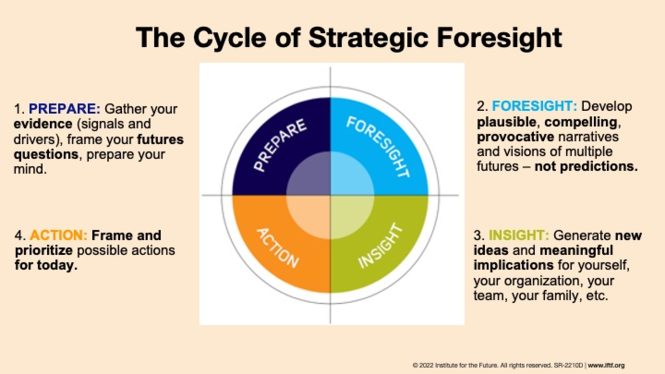Photo by Tom Parkes on Unsplash
Being Future Ready is the first of the leadership qualities of the future leader. It is about having foresight, having an innovation mindset and being tech-savvy.
To learn more about developing this Leadership Quality, read How Coaching Exercises Can Help You Develop into a Successful Future Leader
In a recent post, we looked at the leadership qualities of the future leader: being Future Ready, having a Purpose, having People Skills and being obsessed with Personal Growth. Today we will go deeper into the first of those qualities and look at what it means to be Future Ready.
The world is changing ever faster, and it is no longer VUCA, but it’s also VULCAN or even BANI. So I’m sure someone will create another brand-new acronym next year to tell us how complicated and fast-changing the world is. Whatever. The fact is that it is indeed changing faster and faster, so nobody knows what the world will look like next year, let alone in 5 or 10 years.
Still, the future leader must get to an approximation of what that future may look like. They should understand the drivers shaping the future, workplace trends and the different possible futures that might happen to then help build the best of those possible futures through their actions.
The future leader understands that the future doesn’t happen to us and that we build it with our actions today. They want to play an active role in that building exercise and contribute to shaping a better world for all of us to live in. This is what being Future Ready means.
Being Future Ready can be divided into three parts:
– Having Foresight
– Having an Innovation Mindset
– Being Tech-savvy
Foresight
Foresight is all about using the right tools and resources to understand the future better. Futures thinking is a science in itself, with its own discipline and methodology. The future leader doesn’t need to be an expert on it, but they need to understand the basics and have some notions in order to understand and shape the future.
If we look at the foresight methodologies of the Institute For The Future, one of the leading organisations dedicated to futures thinking, the future cannot be predicted, but it can be understood and explored and then acted upon. The objective of futures thinking is to understand the possible futures in front of us to make the most desirable one happen. It is an action-oriented approach.
The IFTF describes four phases in their Strategic Foresight cycle: in the Preparation phase, the futurist collects the signals and other data; in the Foresight, they develop narratives via scenarios or forecasts; in the Insight, they generate new ideas; and in the Action phase they prioritise and execute actions.

The Future Ready leader should follow the same approach.
Some tools
The futures thinking practitioner has many tools in their toolkit (read more about one here: Ride the Two Curves of the Future of Work). Of course, the future leader doesn’t need to master all of them, but at least they should be familiar with some and use them regularly.
As the science fiction writer William Gibson said, “the future is already here, it’s just not evenly distributed”. This means we can today already see signals of what the future will be like in a few years. We can do that by looking for signals of change and evaluating them.
Signals of change are those pieces of the future that are already here. They are the political, cultural, technological or sociological changes that tell us about the future we are going into. A good futurist collects signals of change and reflects on what those signals tell them.
When you find several or many signals that go in the same direction, you have a driver for change, which, if big enough, will form a trend. Drivers and trends are big swifts or changes that are happening on a big scale. For example, automation caused by AI and robotics is a trend, as is the recent push towards working remotely or the demographic shifts we see worldwide.
A leader with foresight will look at signals of change and trends and will produce forecasts of the future (like these about 2050 and 2100) or scenarios that will imagine different possible futures (like these about a possible day in 2040, a dystopian world in 2050, or life in the Age of Abundance). A forecast is based on a projection of a current trend, whereas a scenario requires more creativity and imagination, it is more open-ended. One projects into the future, and the other tries to imagine possible futures.
Both are useful, as they help us better understand the future and prepare for it.
To build a better future, we first need to understand what options we have and what shape the future can take. There are always different options, but you need to know what they are.
Innovation Mindset
Being Future Ready also means having an innovation mindset, as we don’t want a leader who passively accepts the future but one who actively shapes and models it. For that, you need innovation.
No one is born an innovator, but we all can become one. It’s all about having the right mindset. It’s about understanding the world is constantly changing, being open to that change, and learning from it.
An innovator takes risks, tries new things, experiments constantly until finding the right solution, and accepts failure as an essential part of learning and growth.
A leader with an innovation mindset doesn’t accept the status quo, and constantly challenges others and themselves to look at things from new perspectives and do things differently.
Often when we think about an innovator, we imagine someone like Steve Jobs, but to tell the truth, an innovator should be more like a small child discovering the world around them: everything surprises them, but nothing surprises them too much, as they discover the laws and rules governing the world. Having an innovation mindset means having, above everything else, an open mind.
Innovation is not only about technology. A leader with an innovation mindset will try to apply this mindset to everything: to their business model, to the way they lead their teams, their client relationships, products and services… They will constantly test new ways of doing things and learn and grow as they do so.

Human beings are not wired to think exponentially. We are more comfortable thinking linearly. However, we are now in the Exponential Age, where almost everything is possible, and the future leader knows this and is comfortable in this environment. They know that with an innovation mindset, they are ideally suited to take maximum advantage of this environment.
Tech-savvy
We are living in the Exponential Age thanks in significant part to technology. We have seen more technological advances in the last few decades than in all previous history.
Some people believe that technological progress is slowing down, but I think it is still accelerating. The future leader is tech-savvy and knows how to make the most of this technological progress.
That doesn’t mean that the future leader is a technologist, an inventor or an engineer. They don’t need to be, they have teams for that, but they need to understand the possibilities new technology opens for them and leverage those possibilities to the maximum.
Artificial Intelligence
Let’s start with Artificial Intelligence. AI is evolving very quickly, and it will be one of the most important technologies of this decade (and probably the next ones). As we have seen this year with ChatGPT for writing and Dall-E for creating visual art, AI can automate not only repetitive tasks that require low qualifications, but also creative tasks requiring expertise and deep thought.
Even if AI becoming conscious is still a distant possibility, it brings a new type of intelligence into organisations, an intelligence that hitherto did not exist. Artificial Intelligence is capable of analysing vast troves of data very quickly to find patterns we wouldn’t be able to find and make predictions that would escape us.
As some of the funniest episodes of ChatGPT have shown us, AI is also capable of making silly mistakes and often lacks the most basic common sense that a five-year-old child is endowed with.
This means that in the future we will have mixed teams with human and artificial intelligence, and the future leader will have to know how to manage those teams to the best of their abilities. They will know how to maximise those mixed intelligence teams to be as effective as possible. They will leverage artificial intelligence to make the most of it and also to empower human thinking further.
But AI isn’t the only technology worth talking about out there.
Tech trends
AI deserves its unique place as it will continue revolutionising the tech and business worlds and impacting all our processes and business models. Still, other technological trends will affect the world this decade and beyond. The Future Ready leader will be aware of those trends and will know how to leverage them for the success of their organisations and teams.
The metaverse and web 3.0 were a damp squib in 2022, but they will come back stronger and take more space in our lives.
Quantum computing, fusion energy, Virtual Reality, the Internet of Things, or technologies enabling a more sustainable world will be increasingly important in the years and decades to come.
How will they affect the way we carry out our work? What new business models will they enable? How can they be leveraged to better manage and motivate our teams and satisfy our clients?
The future leader will ask themselves these and similar questions and (hopefully) will find the correct answers.
Being Future Ready to build a better future
Great leaders do many things. They help people grow, drive success, create and communicate an inspiring vision of the future, manage and allocate resources effectively, make the right decision more often than the wrong one, and many other things.
In an ever-changing environment, the leader who wants to be successful in the future will also have to understand the coming future, be prepared for it and shape it in a way that benefits them, their organisation and society at large.
This is why being Future Ready will be one of the main qualities of the future leader. Those who aren’t ready for the future won’t be able to bear all its fruits.